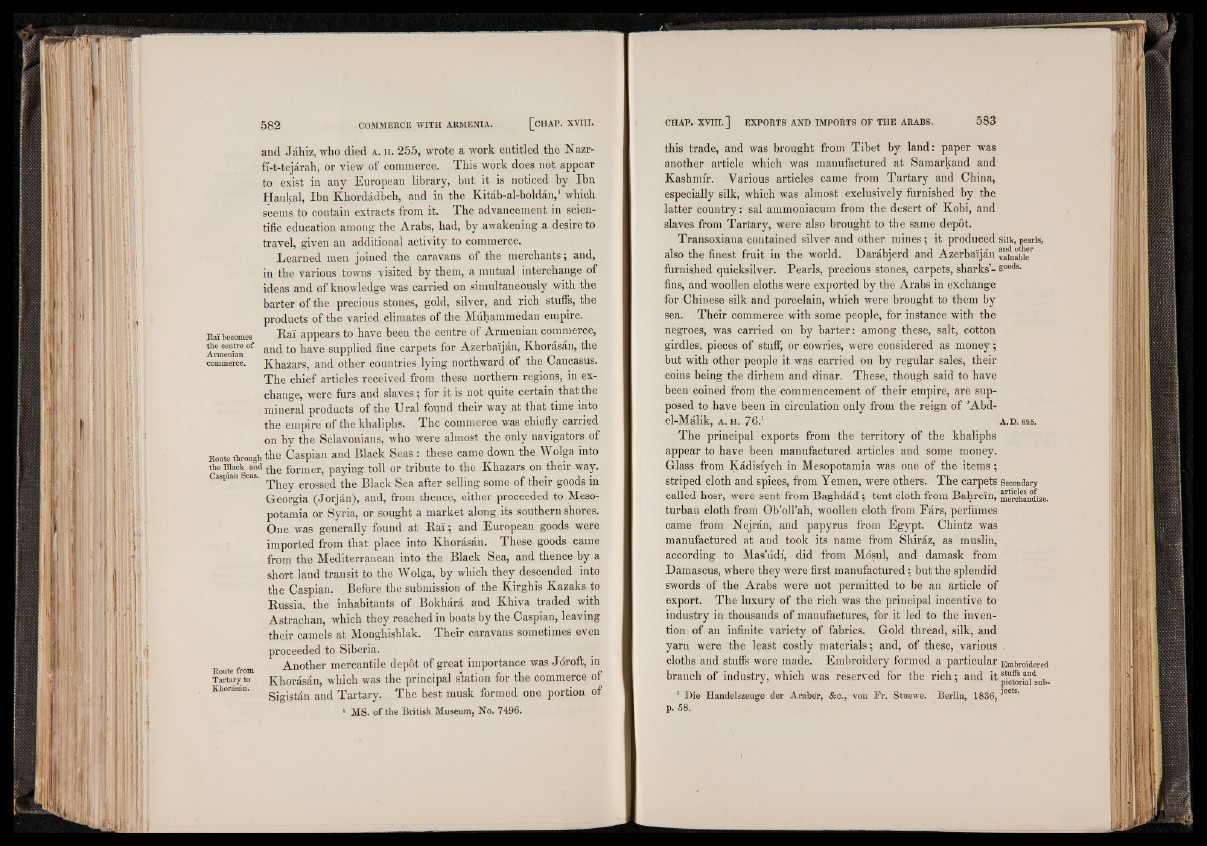
and Jahiz, who died a . h . 255, wrote a work entitled the Nazr-
fi-t-tejarah, or view of commerce. This work does not appear
to exist in any European library, but it is noticed by Ibn
Haukal, Ibn Khordadbeh, and in the Kitab-al-boldan,1 which
seems to contain extracts from it. The advancement in scientific
education among the Arabs, had, by awakening a desire to
travel, given an additional activity to commerce.
Learned men joined the caravans of the merchants; and,
in the various towns visited by them, a mutual interchange of
ideas and of knowledge was carried on simultaneously with the
barter of the precious stones, gold, silver, and rich stuffs, the
products of the varied climates of the Muhammedan empire.
Rai becomes Ra'i appears to have been the centre of Armenian commerce,
Armenian and to have supplied fine carpets for Azerbaijan, Ivhorasan, the
commerce. Khazars, and other countries lying northward of the Caucasus.
The chief articles received from these northern regions, in exchange,
were furs and slaves 5 for it is not quite certain that the
mineral products of the Ural found their way at that time into
the empire of the khaliphs. The commerce was chiefly carried
on by the Sclavonians, who were almost the only navigators of
R o m e t h r o u g h the Caspian and Black Seas : these came down the Wolga into
the ®an°^e“ d the former, paying toll or tribute to the Khazars on their way.
Caspian as. crosged Black Sea after selling some of their goods in
Georgia (Jorjan), and, from thence, either proceeded to Mesopotamia
or Syria, or sought a market along its southern shores.
One was generally found at Ra'i; and European goods were
imported from that place into Khorasan. These goods came
from the Mediterranean into the Black Sea, and thence by a
short land transit to the Wolga, by which they descended into
the Caspian. Before the submission of the Kirghis Kazaks to
Russia, the inhabitants of Bokhara and Khiva traded with
Astrakhan, which they reached in boats by the Caspian, leaving
their camels at Monghishlak. Their caravans sometimes even
proceeded to Siberia.
„ . Another mercantile depot of great importance was Jdroft, in Route i r0111 , ( ^ * . p , 1 _ p
T a rtary to Khorasan, which was the principal station tor the commerce 01
Khorasan. and Tartary. The best musk formed one portion of
1 MS. of the British Museum, No. 7496.
this trade, and was brought from Tibet by land: paper was
another article which was manufactured at Samarkand and
Kashmir. Various articles came from Tartary and China,
especially silk, which was almost exclusively furnished by the
latter country: sal ammoniacum from the desert of Kobi, and
slaves from Tartary, were also brought to the same depot.
Transoxiana contained silver and other mines; it produced silk, pearls,
also the finest fruit in the world. Darabjerd and Azerbaijan “ liable1'
furnished quicksilver. Pearls, precious stones, carpets, sharks’- goods‘
fins, and woollen cloths were exported by the Arabs in exchange
for Chinese silk and porcelain, which were brought to them by
sea. Their commerce with some people, for instance with the
negroes, was carried on by barter: among these, salt, cotton
girdles, pieces of stuff, or cowries, were considered as money;
but with other people it was carried on by regular sales, their
coins being the dirhem and dinar. These, though said to have
been coined from the commencement of their empire, are supposed
to have been in circulation only from the reign of ’Abd-
el-Malik, a . h . 7 6 . 1 a . d . 695.
The principal exports from the territory of the khaliphs
appear to have been manufactured articles and some money.
Glass from Kadisiyeh in Mesopotamia was one of the items;
striped cloth and spices, from Yemen, were others. The carpets Secondary
called hosr, were sent from Baghdad; tent cloth from Bahrein, merchLdlze.
turban cloth from Ob’oll’ah, woollen cloth from Fars, perfumes
came from Nejran, and papyrus from Egypt. Chintz was
manufactured at and took its name from Shiraz, as muslin,
according to Mas’udi, did from Mosul, and damask from
Damascus, where they were first manufactured; but the splendid
swords of the Arabs were not permitted to be an article of
export. The luxury of the rich was the principal incentive to
industry in thousands of manufactures, for it led to the invention
of an infinite variety of fabrics. Gold thread, silk, and
yarn were the least costly materials; and, of these, various .
cloths and stuffs were made. Embroidery formed a particular Embroidered
branch of industry, which was reserved for the rich; and it^riai'sub-
1 Die Handelszeuge der Araber, &c., von Fr, Stuewe. Berlin, 1 8 3 6 ,3e° S’
p. 58.